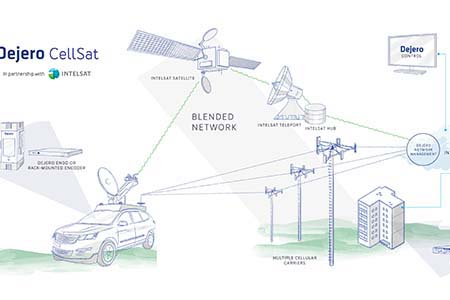HEVC was developed in response to the growing need for higher compression of moving pictures. While it has much promise as a compression technology, HEVC is probably not the wisest choice for truly live transmission, says Shawn Carnahan High Efficiency Video Coding (otherwise known as HEVC or H.265) promises improvements in both bitrate and picture […]
HEVC was developed in response to the growing need for higher compression of moving pictures. While it has much promise as a compression technology, HEVC is probably not the wisest choice for truly live transmission, says Shawn Carnahan
High Efficiency Video Coding (otherwise known as HEVC or H.265) promises improvements in both bitrate and picture quality. It is the first codec wholly designed in the modern video environment, where file movement and delivery to the home is becoming the standard. As such, HEVC lends itself to new methods of moving content for which previous codecs were not optimised. These benefits have the potential to ripple throughout the broadcast ecosystem.
HEVC was developed in response to the growing need for higher compression of moving pictures for various applications such as internet streaming, communication, video conferencing, digital media storage and television broadcasting. It is also designed to enable the use of coded video representation in a flexible manner for a wide variety of network environments, and is the fundamental enabler for UHDTV/4K video resolutions both in professional contribution workflows and delivery to the end user.
Benefits for the media enterprise
While revenue from consumers is the most widely publicised goal, there are equally and potentially more immediately addressable applications of HEVC in the file-based operations on which media companies rely. HEVC is not simply a benefit for last-mile delivery it has important and pressing advantages in the back-end movement of video.
One example can be seen in the flow of moving video material between an organisations facilities. In a report released in August 2012, the average cost of a satellite transponder (worldwide) was USD1.62 million per year for 36 megahertz of capacity. At that price, it is incumbent on operators to make the most of their existing capacity. The ability to get more from a single transponder translates into significant operational cost savings. So, when a network production centre in Los Angeles needs to send material over a satellite to a distribution centre in New York, HEVC provides the advantages of in the same transponder bandwidth moving either better quality video, more video, or simply the same video at a lower bitrate.
Additional savings may be found in storage capacity for VOD and web distribution. HEVC provides the benefits of storing content in less space than current formats and/or storing higher quality content in storage capacity equivalent to what is used today. And while the benefits of monetised VOD services are predicated on consumer-level devices being able to take that HEVC stream and decode it, such devices are already coming to market. Adoption of the technology in delivery to the home via non-IP-based applications will likely be slowed by the lack of HEVC-capable set top boxes in the general population. It is for this reason that we should expect initial adoption of the technology to be in the contribution and OTT domains.
HEVC for delivery
While there are potential uses for live HEVC encoding and it will certainly be adopted for that purpose there are constraints on a live encoder that prohibit making use of the entire HEVC toolkit to best effect. There are a number of tools in the HEVC encoding toolkit that cannot be used to full effect in live encoders because they are restricted by the latency constraint that is mandatory in live work, which by definition limits the number of frames available at any point in time for the encoder to use in its predictive activities. Its use in live UHDTV/4K applications is also somewhat limited, as most UHDTV/4K live encoders break the picture up into 4HD image tiles and process those independently. This leads to major issues at tile boundaries, resulting in considerably reduced bitrate efficiency. So while it has much promise as a compression technology, HEVC is probably not the wisest choice for truly live transmission.
Fortunately, an increasing amount of what people view today is pre-prepared content. In truth, with the exception of live sports events or news, traditional broadcast relies on large quantities of pre-prepared material, and VOD and “catch up TV” operations are basically 100% pre-prepared. When repurposed for re-use on websites, some of these live use cases also transform into pre-prepared content. Freed of the constraints of live encoding, these use cases can take advantage of the advanced features of HEVC, using the full toolkit and extracting the maximum image quality (and revenue) from the source material.
The benefits of HEVCs enhanced compression capabilities can be significant in multiscreen and VOD applications in areas other than inter-facility transfer and media storage. Consider the following real-world example: Delivery of a single 120-minute movie at Wi-Fi level bitrates (8.5Mb/s video, 64Kb/s audio) via a well-known CDN using AVC would cost approximately USD0.441 per delivery. HEVC offers the means to significantly reduce those delivery costs. A 50% reduction in bitrate, applied over many different titles for many different markets, soon adds up to a substantial reduction in cost of delivery.
Using less bandwidth is not the only opportunity, though. A more efficiently delivered video stream is less susceptible to stutters, stalls and buffering issues, and removing these has been demonstrated to improve the overall viewer experience, with clearly documented improvements in consumer retention rates, which again translates into increased profitability for the media enterprise.
HEVC is not only a solution for higher quality or greater efficiency. Rather, HEVC provides the flexibility to strike an optimal balance between the two, finding a sweet spot that makes the most sense for a particular business model increasing the variety of services, enabling the introduction of new services, and managing capital and operating expenses.
The benefits of HEVC are not binary, and an operator is not forced to choose greater efficiency or higher quality. Operators can adjust the encoding to produce the video quality and bitrate that they believe fulfils their business needs.
Developing an HEVC encoder is a very complex piece of work that requires a significant investment in research and development. As a result, three distinct methodologies have emerged among encoder manufacturers.
Many manufacturers outsource development of their codecs to a third party that specialises in that technology. In fact, the majority of encoders rely on codecs created by a single vendor. While this approach can be cost effective, it necessarily entails ceding control over development to a third party and accepting that the codec will be fundamentally similar to many competing products.
A second approach is for the developer to design the codec entirely in-house. While this approach gives the manufacturer full control, it is costly and limits the capabilities to the expertise of the staff on hand.
A third, highly compelling approach is to adopt the open source model. Instead of being limited to an R&D department that fits into one floor of an office building, open source development uses the expertise of a global community of experts that spans the world. Leading experts in universities and private labs bring incredible creativity and knowledge to bear on the challenge. In the case of HEVC, this approach has given rise to the x265 organisation.
This approach makes it possible to build on the tremendous power of the best of the x264 technology, also developed by an open source team exceeding 110 in number, and apply these techniques to the x265 encoder design.
HEVC is a highly advanced encoding standard, offering the possibility of dramatic improvements in compression efficiency and deliverable image quality, and providing significant benefits to consumers and media enterprises alike. HEVC has an extensive set of tools in its arsenal, but some aspects require that the encoder have access to significant numbers of frames in the asset in order to make the best use of the available bits, which means live encoders may not be able to make full use of all of the tools available to them.
Shawn Carnahan is CTO at Telestream.
















































































